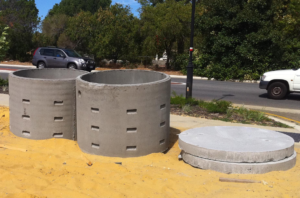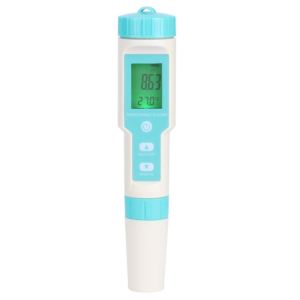Most councils in Western to stipulate that all stormwater that lands on a property must be retained on site. A soakwell system can achieve this.
Soakwells Perth are underground structures that divert rainwater from downpipes, allowing it to slowly drain through the soil and prevent damage caused by sudden rainstorms. They come in a range of sizes and capacities.

Soakwells are a great way to prevent soil erosion on your property. Soil erosion occurs when heavy rainwater washes away the good topsoil, causing it to break up and be carried away by water or wind. This process can destroy entire landscapes, making reversing the damage difficult once it starts. However, you can prevent this by ensuring your drainage system works correctly, including installing soakwells underneath downpipes to disperse excess stormwater.
Unlike stormwater tanks or drains, soakwells are large, porous underground structures designed to infiltrate and disperse water into the surrounding sandy soil. Soakwells are more efficient at this than standard drainage pits because they have a much higher storage capacity and are specifically designed to withstand ground pressure. They also have a knock-out center or bottom inlet/outlet for controlled flow and to ensure the tank is not flooded by high rainfall.
The best soakwells are concrete and have wider openings than plastic ones, allowing the rainwater to enter more easily. In addition, they are surrounded by geotextile lining and compacted with sand at the base to keep them stable. This ensures the soakwell is not clogged with debris and remains free-flowing.
Once the soakwell has been properly installed, it will require minimal maintenance and emptying. This makes them a convenient stormwater management solution for homeowners. They can prevent structural damage, soil erosion, and landscaping issues caused by poor stormwater management, saving you the cost of dealing with these problems later on.
Soakwells are a must-have for any home in Western Australia because they help prevent soil erosion and other costly damages from overflowing drains, downpipes, or gutters. As a homeowner, you are legally required to ensure that all stormwater is retained on your property and does not run off into roads or onto neighboring properties. Soakwells are an ideal way to achieve this because they can hold large amounts of water and are simple to install. You can also use strategies, such as installing drainage systems and terracing, to manage your rainfall effectively.
Soakwells prevent damage to pavements by managing excess rainwater and allowing it to percolate into the soil. This reduces the pressure on driveways and paths caused by rainfall, preventing cracking and sagging. Soakwells also qualify for natural stormwater drainage, which keeps the soil healthy, prevents erosion, and reduces the need for expensive rehabilitation.
Soil erosion is a common problem in Western and can cause significant damage to paving, landscaping, and soil around your property. Soakwells help prevent this by allowing rainwater to drain through downpipes and into the soakwell, where it can slowly seep into the ground. By avoiding surface runoff, soakwells can also reduce the amount of sediment and debris that enters rivers and lakes.
Concrete soakwells are the most popular choice for homeowners, with their durability and longevity making them a good investment. They come in a variety of sizes from 66 liters up to 5000 liters and can be buried up to 300mm below ground level. Typically, they are designed in cylinders and may be stacked on each other to increase their capacity. They also feature large round concrete lids directly on the soakwell, protecting traffic above.
A soak well is an underground tank that allows rainwater to seep into the soil, preventing erosion and keeping the topsoil in good condition. During storms, rainwater flows into the soakwell from downpipes attached to gutters on most residential properties. This water is then drained slowly into the surrounding soil to minimize the impact on other areas of the property.
An effective rainwater management system is vital to the health of your property and its foundations. Not properly drained rainwater can cause topsoil erosion, foundation cracking and movement, moisture problems in walls and ceilings, and even a sagging building or concrete pad.
Many people treat rainwater management as an insignificant issue and discard the rainwater from downpipes onto neighboring properties or the street. This is not only environmentally irresponsible but can also cause several problems with your property, including soil erosion, potential foundation damage, and rising dampness. By having a soak well installed by an experienced plumber, you can ensure that your property is well-maintained and protected against water retention.
Rainwater that falls onto roofs and hardscaped areas travels through stormwater pipes to soak wells or underground tanks. The soakwells are then designed to seep into the soil gently. Soak wells help prevent soil erosion and damage to the topsoil, leading to foundation problems in homes. This helps to protect the integrity of a home’s foundations, which is essential for structural stability and longevity.
If the soil around your home is constantly being eroded by stormwater, the structure of your house will become unstable. This can cause sagging in the building’s foundation and damp walls. If the problem is not addressed early enough, it may result in the need for expensive repairs and maintenance to your home. By directing stormwater into soakwells, you can avoid these potential issues.
Soakwells are large porous vessels buried underneath the ground, capturing a large volume of stormwater and allowing the water to settle in the surrounding sandy soil gradually. They can be made from plastic, polypropylene, or concrete. They are often connected to the downpipes leading from gutters and are present in almost all outdoor habitations, driveways, and impermeable carparks that require stormwater drainage.
Dealing with stormwater has become an important issue for homeowners in Perth. It is now a legal requirement for new homes to install a stormwater system that effectively drains the excess rainwater. This is especially true if the house is in an area with much rainfall.
Rainwater can build up on the property without a proper stormwater management system and potentially flood into the house or adjacent properties. This can lead to significant damage and even structural failure of the home. It can also cause a lot of inconvenience to neighbors and other people living in the vicinity.
Soakwells can prevent flooding and other stormwater-related issues by ensuring the excess stormwater is directed to a perforated tank for slow dispersal into the surrounding soil. This way, the rainwater will not cause soil erosion or damage to paving and other hardscaping elements and won’t impact neighboring properties.
Soakwells are designed to capture stormwater, infiltrate it into the soil, and slowly reintegrate it into the natural water cycle. The process also helps to recharge the groundwater table and create a more sustainable environment. This is why soakwells are important for both the environment and your property. Contact a soakwell specialist to discuss your needs and find the best solution.
Heavy rains can cause a lot of damage to your home and garden. Soakwells help to prevent this damage by draining the rainwater away from your property and allowing it to seep into the soil. This can prevent soil erosion and preserve your plants. It can also protect your house from foundation problems. If rainwater pools against the cement or concrete foundations of a building, it can weaken them and lead to structural issues. Soakwells are a great way to avoid these problems by preventing the rainwater from pooling around your foundations.
Another benefit of soakwells is that they help to prevent damage to the pavements near your home. If the pavements are properly drained, they can crack and become usable. Soakwells can help to avoid this problem by managing the excess rainwater and allowing it to seep into the ground instead of damaging the pavements.
It’s also important to note that if you live in a flood-prone area, it’s likely that the local council will require you to have soakwells installed on your property. This is because they are a crucial part of the flood management system. Soakwells can also help to keep the local waterways clean by preventing debris and rubbish from entering them.
In addition to their environmental benefits, soakwells are cost-effective and easy to install. They are available in various sizes and can be constructed using different materials, including concrete and polypropylene. They are also much cheaper than traditional drainage solutions, such as sand pits and septic systems.
Soakwells are a necessary investment for any property, as they provide many practical benefits and can protect your home from flooding and soil erosion. They can also help you comply with relevant legislation in your region. If you’re interested in a soakwell for your home or business, contact a specialist company such as Awesome Soakwells to learn more about their products and services.

